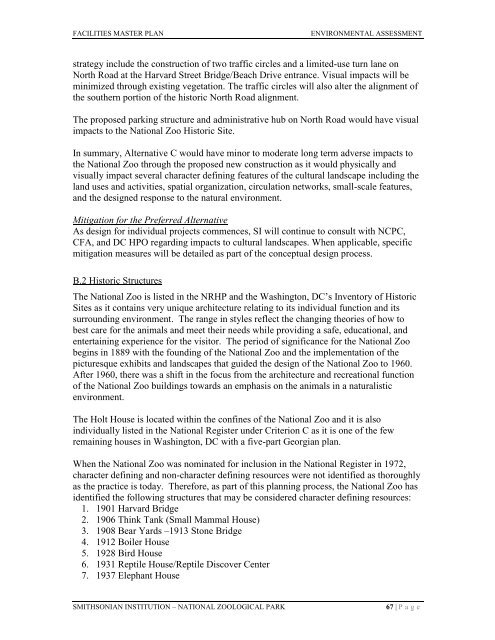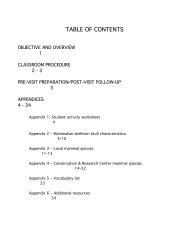facilities renewal master plan - National Zoo - Smithsonian Institution
facilities renewal master plan - National Zoo - Smithsonian Institution
facilities renewal master plan - National Zoo - Smithsonian Institution
Create successful ePaper yourself
Turn your PDF publications into a flip-book with our unique Google optimized e-Paper software.
FACILITIES MASTER PLAN ENVIRONMENTAL ASSESSMENT<br />
strategy include the construction of two traffic circles and a limited-use turn lane on<br />
North Road at the Harvard Street Bridge/Beach Drive entrance. Visual impacts will be<br />
minimized through existing vegetation. The traffic circles will also alter the alignment of<br />
the southern portion of the historic North Road alignment.<br />
The proposed parking structure and administrative hub on North Road would have visual<br />
impacts to the <strong>National</strong> <strong>Zoo</strong> Historic Site.<br />
In summary, Alternative C would have minor to moderate long term adverse impacts to<br />
the <strong>National</strong> <strong>Zoo</strong> through the proposed new construction as it would physically and<br />
visually impact several character defining features of the cultural landscape including the<br />
land uses and activities, spatial organization, circulation networks, small-scale features,<br />
and the designed response to the natural environment.<br />
Mitigation for the Preferred Alternative<br />
As design for individual projects commences, SI will continue to consult with NCPC,<br />
CFA, and DC HPO regarding impacts to cultural landscapes. When applicable, specific<br />
mitigation measures will be detailed as part of the conceptual design process.<br />
B.2 Historic Structures<br />
The <strong>National</strong> <strong>Zoo</strong> is listed in the NRHP and the Washington, DC’s Inventory of Historic<br />
Sites as it contains very unique architecture relating to its individual function and its<br />
surrounding environment. The range in styles reflect the changing theories of how to<br />
best care for the animals and meet their needs while providing a safe, educational, and<br />
entertaining experience for the visitor. The period of significance for the <strong>National</strong> <strong>Zoo</strong><br />
begins in 1889 with the founding of the <strong>National</strong> <strong>Zoo</strong> and the implementation of the<br />
picturesque exhibits and landscapes that guided the design of the <strong>National</strong> <strong>Zoo</strong> to 1960.<br />
After 1960, there was a shift in the focus from the architecture and recreational function<br />
of the <strong>National</strong> <strong>Zoo</strong> buildings towards an emphasis on the animals in a naturalistic<br />
environment.<br />
The Holt House is located within the confines of the <strong>National</strong> <strong>Zoo</strong> and it is also<br />
individually listed in the <strong>National</strong> Register under Criterion C as it is one of the few<br />
remaining houses in Washington, DC with a five-part Georgian <strong>plan</strong>.<br />
When the <strong>National</strong> <strong>Zoo</strong> was nominated for inclusion in the <strong>National</strong> Register in 1972,<br />
character defining and non-character defining resources were not identified as thoroughly<br />
as the practice is today. Therefore, as part of this <strong>plan</strong>ning process, the <strong>National</strong> <strong>Zoo</strong> has<br />
identified the following structures that may be considered character defining resources:<br />
1. 1901 Harvard Bridge<br />
2. 1906 Think Tank (Small Mammal House)<br />
3. 1908 Bear Yards –1913 Stone Bridge<br />
4. 1912 Boiler House<br />
5. 1928 Bird House<br />
6. 1931 Reptile House/Reptile Discover Center<br />
7. 1937 Elephant House<br />
SMITHSONIAN INSTITUTION – NATIONAL ZOOLOGICAL PARK 67 | P a g e

















